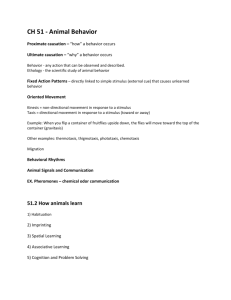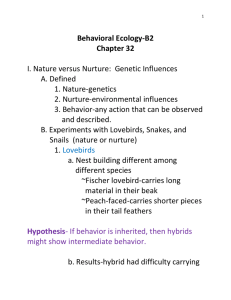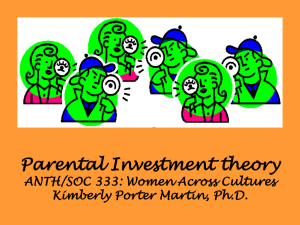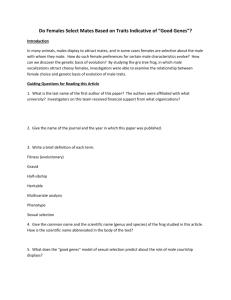chapt45 - Strive Studios
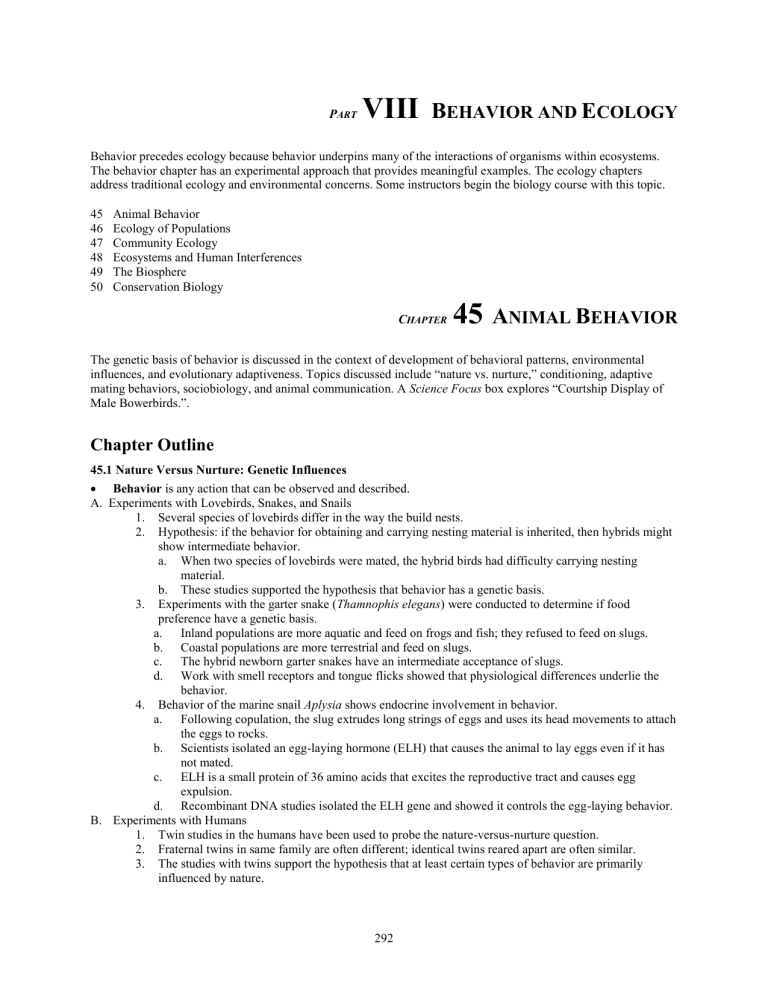
P ART
VIII
B
EHAVIOR AND
E
COLOGY
Behavior precedes ecology because behavior underpins many of the interactions of organisms within ecosystems.
The behavior chapter has an experimental approach that provides meaningful examples. The ecology chapters address traditional ecology and environmental concerns. Some instructors begin the biology course with this topic.
45 Animal Behavior
46 Ecology of Populations
47 Community Ecology
48 Ecosystems and Human Interferences
49 The Biosphere
50 Conservation Biology
C HAPTER
45
A
NIMAL
B
EHAVIOR
The genetic basis of behavior is discussed in the context of development of behavioral patterns, environmental influences, and evolutionary adaptiveness. Topics discussed include “nature vs. nurture,” conditioning, adaptive mating behaviors, sociobiology, and animal communication. A Science Focus box explores “Courtship Display of
Male Bowerbirds.”.
Chapter Outline
45.1 Nature Versus Nurture: Genetic Influences
Behavior is any action that can be observed and described.
A. Experiments with Lovebirds, Snakes, and Snails
1.
Several species of lovebirds differ in the way the build nests.
2.
Hypothesis: if the behavior for obtaining and carrying nesting material is inherited, then hybrids might show intermediate behavior. a. When two species of lovebirds were mated, the hybrid birds had difficulty carrying nesting material. b. These studies supported the hypothesis that behavior has a genetic basis.
3.
Experiments with the garter snake ( Thamnophis elegans ) were conducted to determine if food preference have a genetic basis. a.
Inland populations are more aquatic and feed on frogs and fish; they refused to feed on slugs. b.
Coastal populations are more terrestrial and feed on slugs. c.
The hybrid newborn garter snakes have an intermediate acceptance of slugs. d.
Work with smell receptors and tongue flicks showed that physiological differences underlie the behavior.
4.
Behavior of the marine snail Aplysia shows endocrine involvement in behavior. a.
Following copulation, the slug extrudes long strings of eggs and uses its head movements to attach the eggs to rocks. b.
Scientists isolated an egg-laying hormone (ELH) that causes the animal to lay eggs even if it has not mated. c.
ELH is a small protein of 36 amino acids that excites the reproductive tract and causes egg expulsion. d.
Recombinant DNA studies isolated the ELH gene and showed it controls the egg-laying behavior.
B. Experiments with Humans
1. Twin studies in the humans have been used to probe the nature-versus-nurture question.
2. Fraternal twins in same family are often different; identical twins reared apart are often similar.
3. The studies with twins support the hypothesis that at least certain types of behavior are primarily influenced by nature.
292
45.2 Nature versus Nurture: Environmental Influences
1. Fixed action patterns (FAPs) were believed to be behaviors that were always performed the same way, and they were elicited by a sign stimulus.
2.
Many behaviors formerly thought to be fixed action patterns are found to have developed after practice.
3.
Learning is defined as a durable change in behavior brought about by experience.
A. Learning in Birds
1.
Laughing gull chicks beg food from parents by pecking at the parents’ beaks; however, their accuracy improves with practice.
2.
The chicks first peck at any beak model; later they only peck at models resembling the parents.
3.
This interaction between chicks and parents appears to be a FAP.
4.
Imprinting a.
Imprinting , another form of learning, involves a sensitive period .
1) Chicks, ducklings, and goslings follow the first moving object they see after hatching (usually their mother).
2) A sensitive period is the only period during which a particular behavior such as imprinting , develops.
5. Song Learning a.
Song learning in birds involves a sensitive period when an animal is primed to learn; songs heard outside this period have no effect. b.
When provided with an adult tutor , birds learned other species’ songs, indicating that social interactions assist in learning.
B.
Associative Learning
1.
A change in behavior that involves an association between two events is termed associative learning .
2.
Classical Conditioning a.
In classical conditioning , the paired simultaneous presentation of two different types of stimuli causes an animal to form an association between them. b.
This suggests that an organism can be trained (conditioned) to associate any response with any stimulus. c.
Unconditioned responses are those that occur naturally; conditioned responses are those that are learned.
3.
Operant conditioning a.
In operant conditioning, a stimulus-response connection is strengthened. b.
This resulted from reinforcing a particular behavior. c.
F. Skinner was famous for his studies in operant conditioning, always rewarding animals for the proper response.
C.
Other Means of Learning
1.
Animals also learn through insight, observation, and habituation.
2.
Insight learning occurs when an animal suddenly solves a problem without any prior experience with the problem.
3.
Many animals learn through observation and imitation.
4.
Deer grazing on the side of a busy highway, oblivious to traffic, is an example of habituation.
45.3
Adaptive Mating Behavior
1.
Sexual selection refers to adaptive changes in males and females that lead to an increased ability to secure a mate. a.
In males, this may result in an increased ability to compete with other males for a mate. b.
Females may select a mate with the best fitness (ability to produce surviving offspring), thereby increasing her own fitness.
A. Female Choice
1.
Two hypothesis regarding a female’s choice of a mate are: a. The good genes hypothesis contends that females choose mates based on traits for improving the survival of offspring. b. The runaway hypothesis states that females chose mates on the basis of traits that attract them to females; the trait can then become exaggerated until it is a handicap.
2.
The Raggiana Bird of Paradise is dimorphic (males and females differ in size and other traits) a.
The ornateness of the male is a factor in selection by a female.
293
b.
More feathery Raggiana are parasite-free, and their selection by females would increase the chance for survival.
B. Male Competition
1. A cost-benefit analysis can be applied to determine if the benefit of access to mating is worth the cost of competition among males.
2. Baboons have a dominance hierarchy.
a. A dominance hierarchy is a ranking within a group where the higher ranking individuals acquire more resources. b. Dominance is determined by confrontation where one animal gives way to the other. c. Baboons are dimorphic: males are larger and have large canine teeth; they decide when the troop moves, and they defend it. d. Females mate with dominant males when ovulation is near; the dominant males then protect all young. e. The drawbacks to being large and in danger are outweighed by the chance of fathering young. f. The subordinate males have less chance to mate but they do have avenues to have some offspring.
3. Red deer stake out a territory , an area that is defended against competitors. a.
Territoriality involves the type of behavior needed to defend a particular territory. b.
A stag competes for females that form a harem that mates only with him. c.
A stag remains at peak fighting ability for only a short time; one stag can only father about two dozen offspring.
C.
Mating in Humans
1.
Human Males Compete a.
Humans, like many other mammals, are dimorphic. b.
Males are larger and more aggressive, perhaps due to past sexual selection by females.
2.
Females Choose a.
Male mating success correlates best with income—wealthy males attracted mates better than nonwealthy males. b.
Apparently, females prefer to mate with a male who is wealthy and has a successful career—this will ensure that the children will live to reproduce.
3.
Men Also Have a Choice a.
Men prefer women who will present them with children: health, age, “figure,” faithfulness are all factors in a male’s choice of a mate.
45.4 Sociobiology and Animal Behavior
1.
Sociobiology applies the principles of evolutionary biology to the study of social behavior in animals.
2.
It is based on a reproductive cost-benefit analysis of the value of living in a society.
3.
There are both benefits and costs to living in a social group.
4.
Only if the benefits, in terms of reproductive success, outweigh the disadvantages will societies evolve. a. Advantages to living in a social group might include help to avoid predators, to raise young, and to find food.
1) A group of impalas has more eyes to see approaching predators, etc.
2) Many fish moving rapidly in a school can distract a predator.
3) The trumpet manucode (a bird) pair bonds for life; both sexes are needed to raise the young.
4) Weaver birds form giant colonies to protect them from predators.
5) Primate members signal the group when they find a bountiful fruit tree.
6) Lions working together can capture larger prey, such as a zebra or buffalo. b. There are also disadvantages to living in a social group.
1) Disagreements occur between members over the best feeding places and resting sites.
2) Among red deer, subordinate females are at a disadvantage in producing more prolific sons.
3) Primate grooming may be necessary to keep them healthy since parasites spread easily in groups.
A. Altruism Versus Self-Interest
1.
Altruism is defined as behavior that has the potential to decrease the lifetime reproductive success of the altruist, while benefitting the reproductive success of another member of the society.
2.
Fitness, judged by reproductive success, may explain altruistic behavior.
3.
Genes can be passed directly from parents to offspring.
294
4.
Genes are also passed by relatives; an individual helping a relative survive and reproduce passes on the individual’s genes.
5.
Direct selection is adaptation to the environment due to the reproductive success of an individual.
6.
Indirect selection , also called ken selection , involves adaptation to the environment due to the reproductive success of an individual’s relatives.
7.
Thus, the inclusive fitness of an individual includes personal reproductive success plus that of its close relatives.
8.
In social insects, altruism is extreme and is explained on the basis that it helps reproducing siblings survive. a.
Only the queen among an army ant colony reproduces; the three castes of ants have given up reproducing. b.
In social bees and wasps, the queen is diploid but the drone is haploid; therefore sterile female workers are 75% related to their nest mates but would be only 50% related to their own offspring if they reproduced; thus, it is an advantage to care for the queen and her offspring.
9.
Male chimpanzees in Africa did not interfere with each other’s matings because they shared genes.
10.
Reciprocal Altruism a.
In some species, bird offspring from one clutch of eggs may stay at the nest to help parents rear and feed the next batch of offspring. b.
For Florida scrub jays, the number of fledglings produced by an adult pair doubled when they had helpers. c.
Mammal offspring also help their parents; African jackals raise 1.4 pups alone; with helpers they raise 3.6. d.
The above are examples of reciprocal altruism : an animal helps or cooperates with another animal with no immediate benefit, but the animal that was helped will repay the debt at a later time.
45.5 Animal Communication
1. Some animals are largely solitary and join with a member of the opposite sex only to reproduce.
2. Others pair, bond, and cooperate in raising offspring.
3. Society members are organized in a cooperative manner extending beyond sexual or parental behavior.
A. Communicative Behavior
1. Communication is an action by a sender that influences the behavior of a receiver.
2. When the sender and receiver are members of the same species, signals will benefit both the sender and the receiver.
3. Chemical Communication a.
These signals are chemicals (e.g., pheromones, urine, and feces) and have the advantage of working both night and day. b. A pheromone is a chemical released to cause a predictable reaction of another member of the same species. c. Female moths attract males with tail gland pheromones; cats mark territory with urine, etc., and antelope mark twigs with eye gland secretions.
4. Auditory Communication a.
Auditory (sound) communication has advantages.
1) It is faster than chemical communication.
2) It is effective both night and day.
3) It can be modified by loudness, pattern, duration, and repetition. b.
Male crickets have calls for reproduction. c.
Birds have various songs for distress, courting and marking territories. d.
Whale songs have six basic themes for sexual and group identification. e.
Only humans can produce many different sounds and assemble them in many different ways. f.
Nonhuman primates are limited to about 40 distinct vocalizations with limited meaning. g.
Chimpanzees using artificial language cannot advance beyond the level of a 2-year-old child. h.
Chimps appear incapable of using language to reason or of using grammar.
5. Visual Communication a. Visual signals are most often used by species that are active during the day. b. Contests between males make use of threat postures and may prevent fighting. c. Defense and courtship displays are exaggerated and always performed in the same way so the
295
meaning is clear.
6. Tactile Communication a.
Tactile communication occurs when one animal touches another. b.
Gull chicks peck at the parent’s beak in order to induce the parent to feed them. c.
A male leopard nuzzles the female’s neck to calm her and to stimulate her willingness to mate. d.
Honeybees use tactile communication to impart information about the environment.
Lecture Enrichment Ideas
Experience Base : Students today generally have reduced experiences personally viewing the behavior of outdoor wildlife; observations of pets, domestic, and zoo animals are unlikely to provide meaning to the many concepts covered in this chapter. Still photos likewise provide a limited understanding of the classic concepts described here.
1.
Discuss why behavior can be assumed to be adaptive and evolving, as exemplified by the behavior of blackcrowned gulls in removing eggshells or by the nest-building behavior of wood-hoopoes.
2.
Darwin was unexpectedly ahead of his time in extending his ideas on natural selection from morphology to behavior. Today, we take behavior as an evolutionary phenomenon as logical, but reading from his early work can give a sense of his insightfulness.
3.
Discuss how imprinting behavior would be useful in both offspring and parents in species such as ducks and geese, where there are numerous offspring that are mobile upon hatching. Should we expect that kind of imprinting in a herd mammal (such as a wild horse or antelope) or a human?
4.
Discuss why it would be advantageous to a female mouse to abort a pregnancy when her mate in the pregnancy is displaced by a new male.
5.
Examples of other work with Aplysia may give students an understanding of why this snail is useful as a “lab rat” for research work that tries to associate behavior with nerve physiology. While it is possible to explain the properties of a building by examining its bricks, it is not always possible to predict the possible emergent properties by studying a brick alone—this is the problem with predicting behaviors from studying nerves and neurons alone.
6.
Lecture question: A cuckoo lays an egg in another bird’s nest; its larger offspring present a larger gape and are thus fed more food by the adoptive parents. Why can’t the host birds evolve a defense against this cuckoo chick behavior?
7.
Darwin is often stereotyped as merely the author of the natural selection mechanism of evolution. However, sexual selection is a concept originating with Charles Darwin (and he wrote books on the earthworm’s role in soil formation and emotions and facial expressions). Discussions on reproductive strategies and parental investment may interest some students in further readings in sociobiology.
8.
Note that Darwin’s theory of natural selection is often reduced incorrectly to “survival of the fittest” in an image of a dog-eat-dog world, all competition and no cooperation. It is more correctly generalized as reproduction of the fittest, and that allows more room for cooperation and sociality if the behavior improves survival of genes common to those who “sacrifice” or cooperate.
9.
If a zoo is located nearby, take a field trip and determine the various forms of communication and behavior among different animals.
10.
Discuss the difference between genuine altruism in humans, where individuals have gone to war and died on behalf of unrelated compatriots, versus animal “altruism” that appears to always be tied to securing some advantage for the individual’s genes in “calculated selfishness.”
11.
Ask students to relate to whom they have helped in the past: hungry relatives or strangers. Most human societies are set up so we give favor to near relatives. Why might this be genetically selected?
296
12.
Discuss the controversies inherent in sociobiology, the theory that human behavior can be explained based on physiology and evolution. Some scientists are reluctant to consider that antisocial behavior may be an inborn part of human nature. Asking for opinions will probably generate a lengthy discussion.
13.
Discuss methods used in human society and interpersonal relations to reduce or overcome aggression. Students should think about how they behave with friends and with strangers, and what they would consider aggressive or submissive behavior.
Critical Thinking
Question 1 . Darwin’s finches were described in the earlier evolution chapter. One finch was called the
“woodpecker finch” because it would use a twig to pry out grubs from holes in trees. Not all finches of this species exhibit the behavior, and most fledglings do not. In addition, there is some variation in how the woodpecker finches handle the “tool”; some toss it away after each try while others carry it as with nesting material. Is this behavior innate or learned? Is it justified to state that the bird is thinking the same thoughts that we would be thinking if we were trying to pry out a morsel of food?
Answer : The behavior is most likely learned, although perhaps a modification of the nest-building instinct that all nesting birds have. Indications that the behavior is learned include not all members of the species exhibit the behavior, younger members do not (suggesting some learning time is involved), and there is considerable variation in the behavior and most innate behaviors are fairly rigid. It is absolutely certain that the bird is not mentally verbalizing the same “thoughts” as we would if we were attempting the task.
Question 2.
Consider the hypothetical situation of having to decide whether to save a drowning person. You are not a good swimmer, so the chance of yourself drowning is one-in-ten. We will propose an “altruism gene” that promotes this behavior. Since there is a 1/10th chance of dying, the chance that this gene will be passed on depends on how closely related the person is you are saving. To keep the gene in our population over time, and recalling basic genetics principles, should we jump in to save a sibling (brother or sister), a cousin, a niece or nephew, a stranger, etc.?
Answer : You would share on average half your genes with a sibling; therefore, the ½ chance of saving the gene is greater than the 1/10th chance of dying—thus you should save a sibling. However, each time an external parent is involved in the lineage, the likelihood of carrying the altruistic gene drops by half. Thus it is still advantageous to save a drowning relative that is 1/4 or 1/8 related; any relative more distantly related is less likely to have the altruistic gene than you are likely to drown and lose the gene, and the gene would likely be lost.
Question 3.
Why should a dominant male baboon move to the front of his troop to defend the females and young when this places him in greater danger of being killed by the challenging lion?
Answer : There is some danger to ending his existence; however, this behavior should result in even more of his genes being passed on by saving these genes in his offspring.
Technology from McGraw-Hill
Please consult your Course Integration Guide for technology correlations for this chapter.
297

